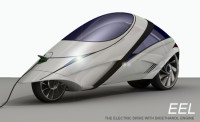Are vehicles getting any lighter?

With the introduction of revolutionary new electric vehicles and hybrids, some automakers are now shifting to smaller and lighter vehicles in an effort to increase fuel economy.
A vehicle’s weight is responsible for most of the energy required to move it, while larger automobiles require larger and often less fuel-efficient engines.
The automotive industry has been slow to introduce lighter weight materials. But in an era of rising fuel prices, automakers have begun to look at vehicle weight more seriously.
Some car designers have long argued that radically cutting the size and weight of cars is the fastest, easiest and cheapest way to reduce fuel consumption and carbon dioxide emissions.
According to the US Department of Energy, reducing a vehicle’s weight by 10% can improve fuel economy by 6-8%.
Steel has traditionally comprised about 60% of a vehicle’s total weight. But to meet increasingly stringent fuel economy standards, automakers are looking to alternatives, including advanced high-strength steel, aluminium, magnesium and carbon fibre.
The use of advanced composite materials, such as carbon fibres, has the potential to reduce weight, but these are currently high price for general mass-market use.
For the full story, see the August 2014 edition of MobileTex. Not a subscriber? Sign up HERE

